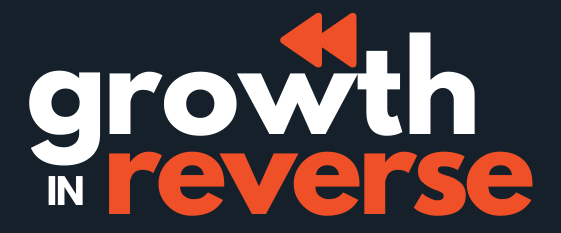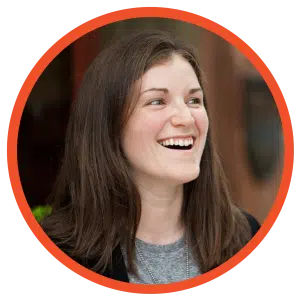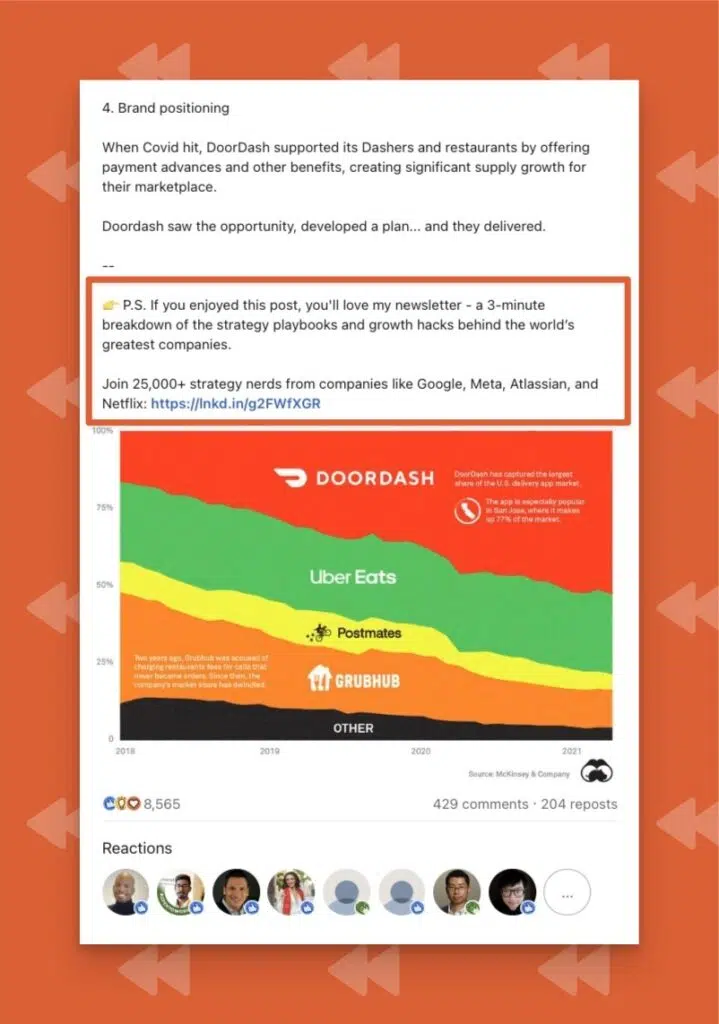There are a LOT of ways to grow a newsletter.
Trust me, I’ve got a whole database filled with growth levers that newsletter creators have used to get to 50k+ subs (you can grab that here).
But you know what almost every single one uses? Social media.
So I thought it was time to share how some of the biggest newsletter creators use social for growth.
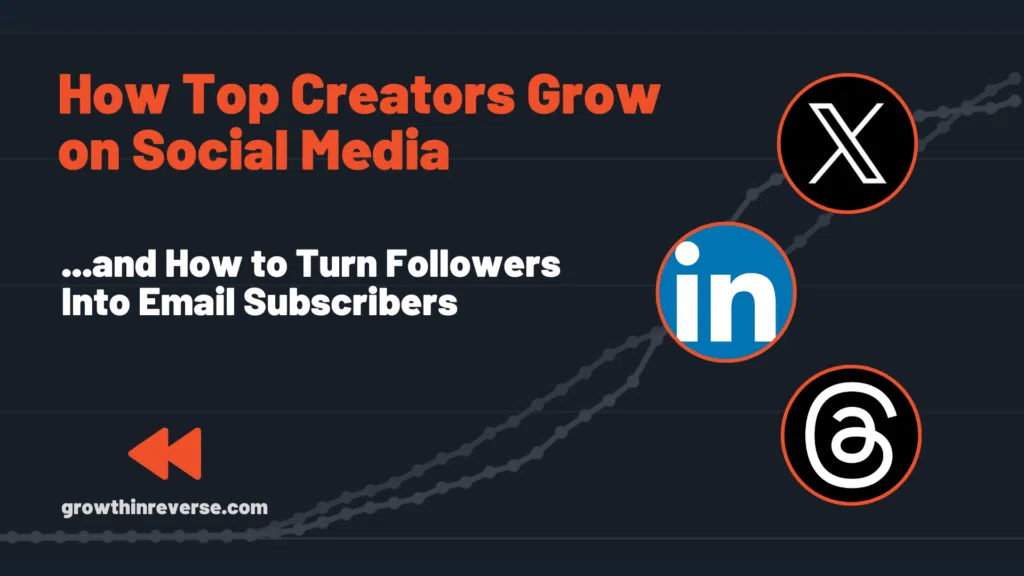
Best Social Channels For Newsletter Growth
You’d likely assume most newsletter creators use writing-based platforms like Twitter/X, LinkedIn, and more recently, Instagram Threads. Newsletters are delivered in written format, so that would make sense.
And the short answer is: yes, most do.
- Yossi Levi (Car Dealership Guy) grew to 463k Twitter followers and his newsletter has crested 80,000 subscribers.
- Justin Welsh has amassed 641k LinkedIn and 500k Twitter followers, which have converted to over 200,000 subscribers.
- Sahil Bloom has over 1M Twitter followers and over 800,000 newsletter subscribers.
Written social platforms can clearly reap major rewards.
But the longer answer is: yes AND.
Written platforms work—AND there are tons of examples of newsletter creators crushing other content formats outside of writing.
For example…
- Daphne Gomez has mastered Instagram to over 121k followers and 100k+ newsletter subscribers.
- Erica Kullberg has over 2.24M YouTube subscribers and 250k+ newsletter subscribers.
- Kylan Scanlon crushes TikTok with economics videos and has 57k subscribers.
I started including those here but the post got way too long, so I’ll include those in Part 2. But I wanted to highlight this now to remind you that not all social media efforts and success are relegated to written platforms.
Okay, let’s get into it.
Strategy #1: Testing Multiple Channels
Not sure where to start?
Neither did Alex Xu, so when he started the ByteByteGo newsletter, he kept doing what he’d been doing for a while:
Reposted what he shared on LinkedIn to Twitter and vice versa.
He posted the exact same content, with minor tweaks. Here is one of his first posts:

And here’s how he changed it slightly for Twitter:

Note: If you look closely, Alex didn’t know what he was doing in the early days. You can see this tweet I outlined in the middle – I think that’s showing up because he didn’t properly know how to write threads, so he was just commenting on his own post 🙂 The takeaway? Start posting now, and figure it out later.
What Alex did with this content was simply format it for the platform. He didn’t change a single word.
Since he didn’t know which channel was going to “work” he tested both with the same content.
And I’ll bet he’s glad he did… because LinkedIn was clearly the winner here.
Look at the growth timeline if we just compare those two channels.
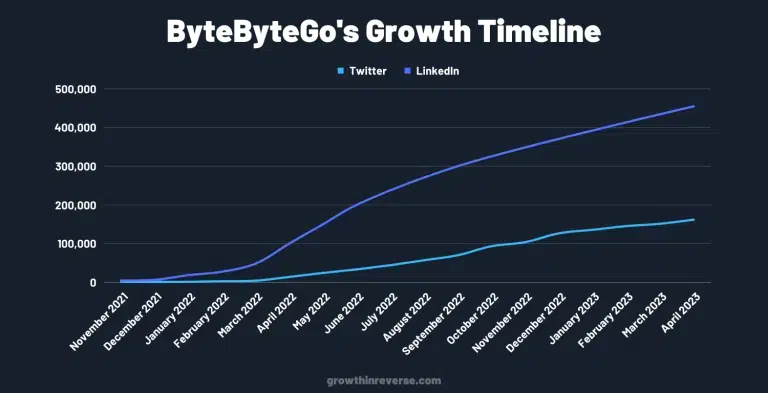
As of Oct 2024, he had 849k followers on LinkedIn and 244k followers on Twitter.
You never know which channel is going to work, so if they are similar enough (like Twitter and LinkedIn) try them both and see what takes off and where you enjoy posting more.
Strategy #2: Success With ONE Channel First
Alex Xu found a channel winner early on and doubled down on it.
But the more common approach is to focus on one channel for audience growth. Especially at first.
That’s what these creators did.
Justin Welsh’s LinkedIn Focus
LinkedIn was the bread and butter for the growth of Justin Welsh. He started in 2018 and has been writing there basically every day since.
He’s gotten so good at understanding what works on the platform that he literally has it down to a science. (I’ll share more on that below).
But LinkedIn wasn’t always the home run for Justin like it is now: it took him years to build up the audience he has now.
He had to experiment to find resonance.
He went from writing about sales and SaaS companies to talking about writing on LinkedIn, to now focusing on the “solopreneur” niche.
It’s worked so well that after ~3 years of posting on LinkedIn and “conquering” the platform, he took what he learned and applied it to Twitter – but not before he already had grown to over 100k followers on LinkedIn first.
Would he have grown as quickly if he had diverted his attention to multiple platforms? Impossible to say, but I’d assume probably not.

There are a number of creators who have done something similar: started on one platform and got so good at it that they hit 100k followers and then moved elsewhere.
Tom Alder did the same thing: he focused on LinkedIn to grow a large audience, converted those followers to subscribers, and then began building on Twitter.
Other examples of this include Sahil Bloom, Nathan Baugh, and Dickie Bush.
Focus on one platform, figure it out completely – what hooks work, how to best engage with other creators, what styles of writing people resonate with, what you like writing about – and then take those learnings elsewhere.
Just more proof that focus can have huge payoffs. You don’t need to be everywhere, at least not at first.
What Do The Most Successful Newsletter Creators Post?
We’ve looked at the written channels these newsletter creators use, but what really matters is: what are they posting to get to these follower numbers?
Sahil Bloom’s Rise to 400k Twitter Followers
Today, Sahil Bloom has 1M Twitter followers.
And he didn’t get there with fame and fortune. He started in May of 2020 with only 500 followers.
But his Twitter growth almost doubled every year:
- May 2020 – 500 followers
- May 2021 – 187k followers
- May 2022 – 580k followers
- May 2023 – 937k followers
So what was he posting to grow his account to such epic proportions?
Well, the Twitter algorithm loves its templates.
And Sahil used several templates to expedite growth (shout out to Ethan Brooks for surfacing these well before this newsletter existed. I would link to the article, but Hubspot removed all the good Trends content once they acquired them).
Here are two examples of templates Sahil used over and over.
Template #1: “The Most Powerful ___”
Early on, Sahil wrote a lot about paradoxes, frameworks, razors, and other concepts.
It makes sense to combine them all together sometimes. And he does this in a clever way using a 1-2 line hook.
Sometimes he includes a “starter” sentence because not everyone might know what a “razor” is outside of a sharp object. Here are a few examples of this in action 🙂
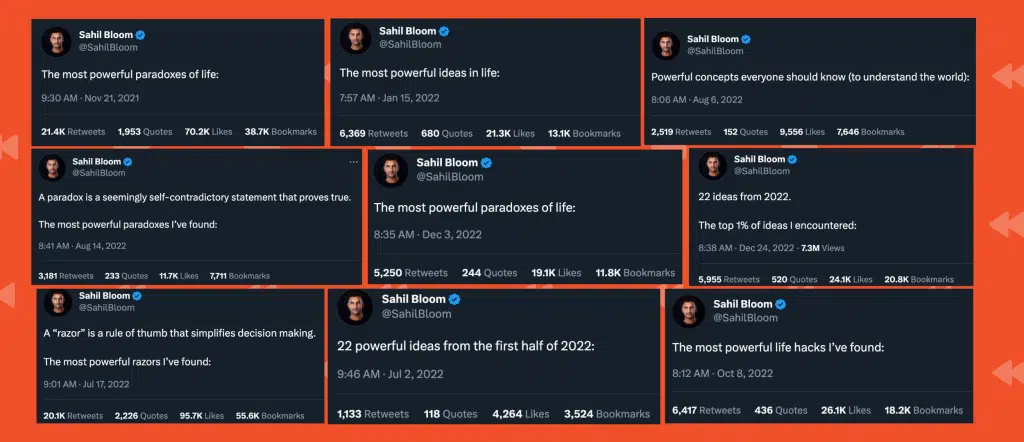
Template #2: The 101 Template
This is probably the most overdone template on Twitter now, but Sahil was doing A LOT of these when he first started.
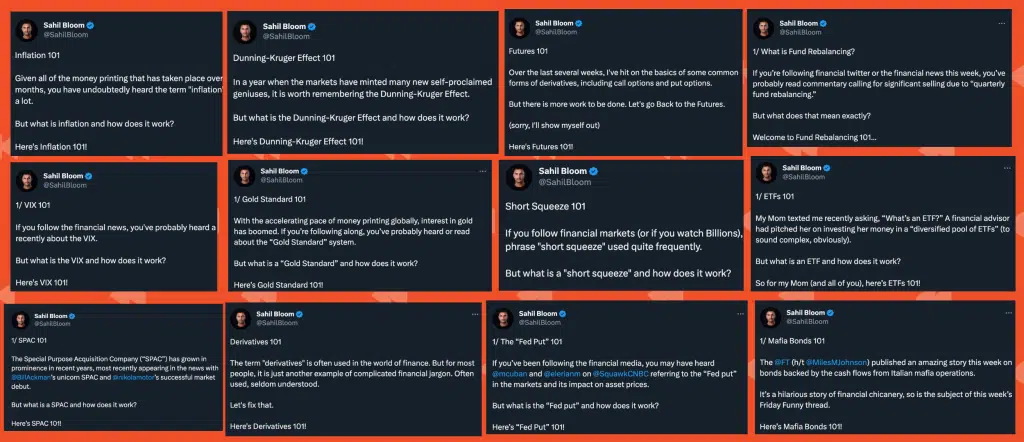
The best part is that these make sense because they are foundational topics he is going to end up linking back to from other threads (like the blogger method above).
Justin Welsh’s PAIPS Formula to 1M+ Social Followers
Justin’s growth to over 1M social followers was no fluke, either.
His posts had themes and used a system he’d created.
Many of the story posts he writes on LinkedIn follow this PAIPS formula:
- Pain – Introduce the problem – “most people post on LinkedIn write lots of posts, but never get any attention. Often, they hear crickets after posting.”
- Agitate – “This means you’re missing out on growing your audience and getting the speaking gigs you want to get booked for.”
- Intrigue – “What if I told you there’s a better way?”
- Positive future – “And it will help you land XYZ client in just 30 days.”
- Solution – “Here’s how to do it.”
It’s simple, but genius. And they perform so well that he can just keep doing them and get incredible results.
The Car Dealership Guy’s ABC Content Strategy
Yossi Levi grew The Car Dealership Guy account anonymously to over 450k followers in 2.5 years.
Here’s how he did it.
1. 4-Week Content Sprints
Yossi breaks up his content into 4-week sprints.
He’ll plan 4 weeks at a time, building out a content calendar and plugging in one of 16 types of content for each day of the week.
2. ABC Posts
Yossi breaks down each piece of content into 10-15 different content buckets and each of those types has its own letter assigned to it.
For example, an “A” post is a short-form stat that generally doesn’t have context.
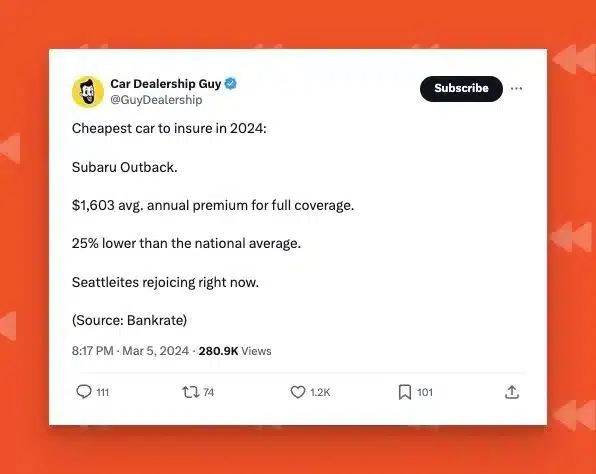
Other post types he uses:
- Short-form stats with no context
- Long-form stats
- Community engagement posts (example)
- User-generated content
- CDG self-promotion
- Memes (example)
- Breaking news/press releases
- Best car deals
- Podcast posts (example)
- Podcast teasers (example)
Every Tuesday and Thursday, he’s putting out a new podcast episode, so that content lives on those days. The day before the episode goes live, he shares a teaser from that podcast, so those are on Mondays and Wednesdays.
And then you can fill in the rest of the calendar with the other content types.
This is what I imagine it looks like to some extent:

I love how formulaic this is.
Every day has 2 (or more) pieces of content that get slotted in. And he color codes each one to make sure he can see a good mix of those various content types throughout the month.
The #1 Key To Twitter Success: Insanely Valuable Content
I think I’ve made it clear to this point that Yossi isn’t posting random thoughts or ideas on Twitter and hoping for the best.
He’s posting content you quite literally won’t find anywhere else.
The car market was like a black box for consumers and other dealers before he showed up. There were many things dealers didn’t want you to know about the process and what was going on.
But having an anonymous account allowed him to share insights and behind-the-scenes info that he probably wouldn’t be able to with his name out there at first.
“The market rewards asymmetrical insight and scarce insights.” – Yossi Levi
How To Turn Followers Into Subscribers
Massive social audiences are great. But we want to convert these eyeballs into newsletter subscribers.
Impressions don’t always translate into subscribers.
So how are they doing it? Let’s take a look at a few examples.
Tom Alder’s ‘Late Edit’ LinkedIn CTA
Tom grew his Strategy Breakdowns newsletter to over 5k subscribers before publishing the first edition. His newsletter now has over 55k subscribers, and he got a lot of them organically from his LinkedIn posts.
Here’s how he does it:
- Tom crafts an in-depth post about a topic or business in his niche (ie. high-value content).
- He publishes the post—but without a CTA or link of any kind (the algorithm doesn’t like outbound links, of course).
- After an hour, Tom hits the “Edit Post” button and adds a ‘PS’ with a link to his newsletter (see example below).
The theory is by the time you add the link an hour later, the initial engagement has LinkedIn’s algorithm showing the post to more and more users. You’ve likely hit some sense of escape velocity at that point, so it won’t hurt the reach of the post as much.
Here’s an example of what he adds:
Tom admits you’ll miss out on some conversions since the impressions from the first hour won’t see the link to subscribe.
But he believes the trade-off of maximizing views by omitting the link in the first hour outweighs the lost opportunity in converting those first-hour impressions.
He explains it all here in under 60 seconds.
Justin Welsh’s Teaser Posts
I’m sure you’ve seen it since it’s been widely adopted (I’ve used this strategy as well) but I wanted to share it here just in case because it works really well when executed properly.
- First Justin shares a hook that creates an open loop or curiosity gap.
- Then he tells you he’s going to share all the details (close the loop) in his newsletter.
- He adds a casual CTA: “If you want to read it, join us here:” + the link to his sign up.
Then, once that edition of his newsletter is published, he drives even more traffic with a post like this:
You might be thinking, “That’s great, but it just drives traffic to his website.”
But check out what you see as soon as you land on that page:
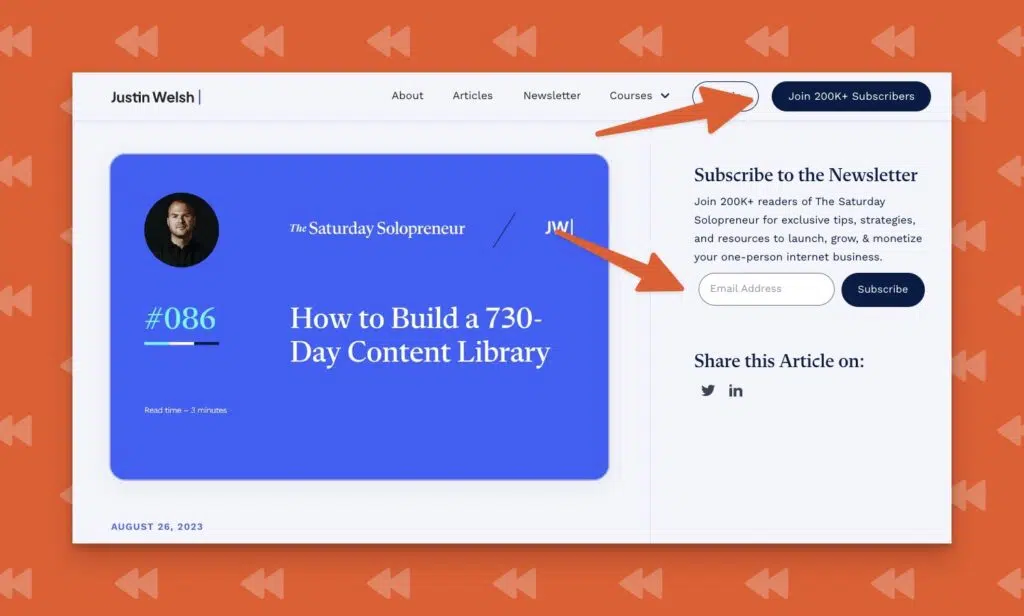
- He includes the exact same image from the post indicating you’re on the right page and reminding you why you landed there (continuity).
- A “Join 200K+ Subscribers” button jumps out in dark blue.
- A non-invasive “Subscribe to the Newsletter” callout in the right sidebar (this is such a better experience than an immediate pop-up or shadowbox modal begging you to subscribe).
And those two CTA’s stay with you as you read. So if at any point you’re thinking, wow this content is great I should subscribe – there is a box staring you right in the face inviting you to do so 🙂
Do you have to use social media to grow your newsletter?
Absolutely not.
However, I’d argue that it is the fastest way to kickstart and sustain your growth.
It’s one of the ways I grew this newsletter in the early days. But after 8 months or so I kind of fell off. And guess what, the newsletter growth slowed quite a bit.
So if you plan on not using it, just accept that you’ll grow a little slower than you would otherwise.
If you have the capacity to double down on social media, these creators (and so many more) are proof that it can reap pretty massive rewards.
If you want to see more examples of how creators are using social growth, I’ve included a number of them in the Growth Levers Library, which you can grab here:
